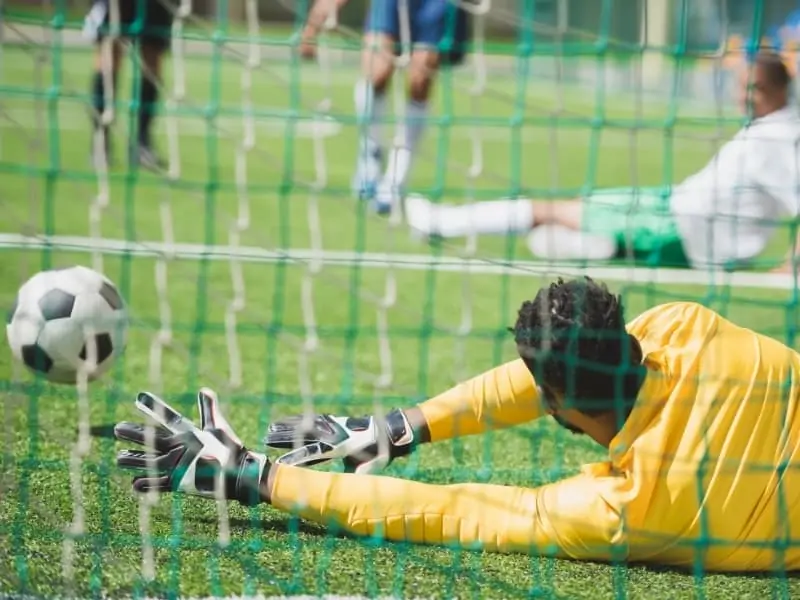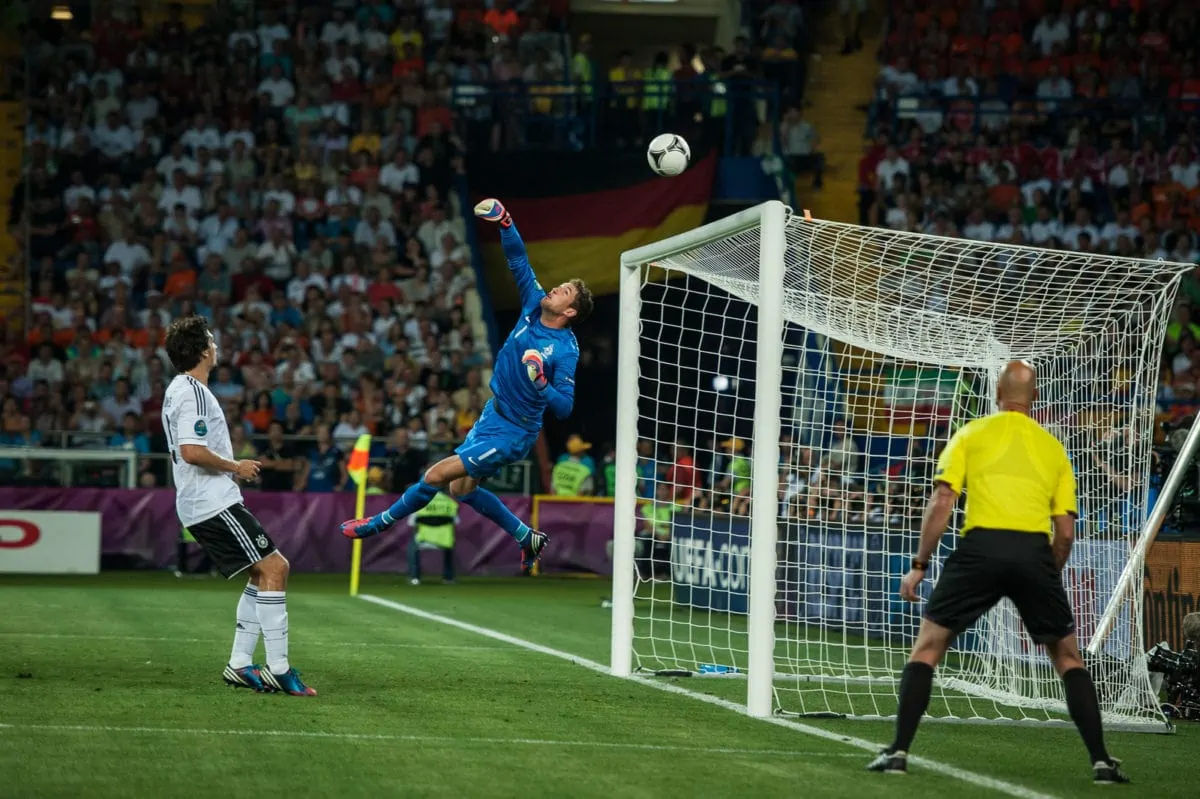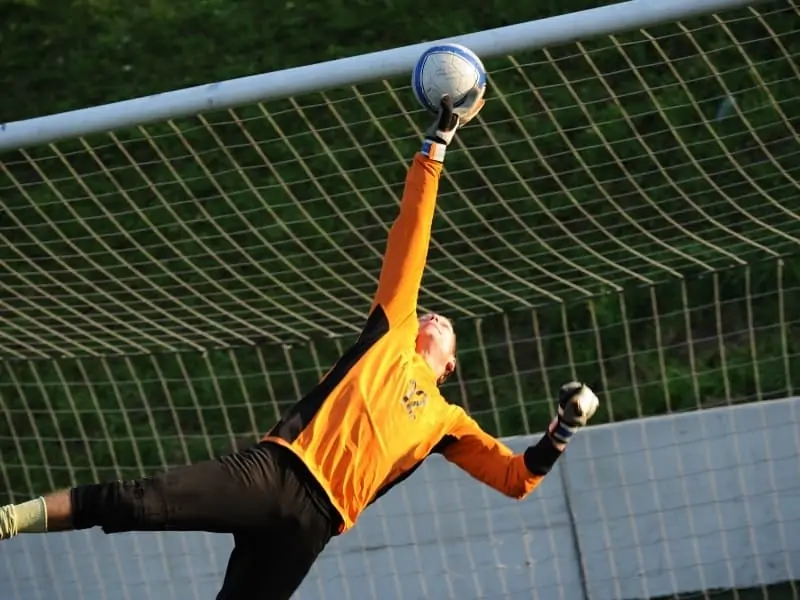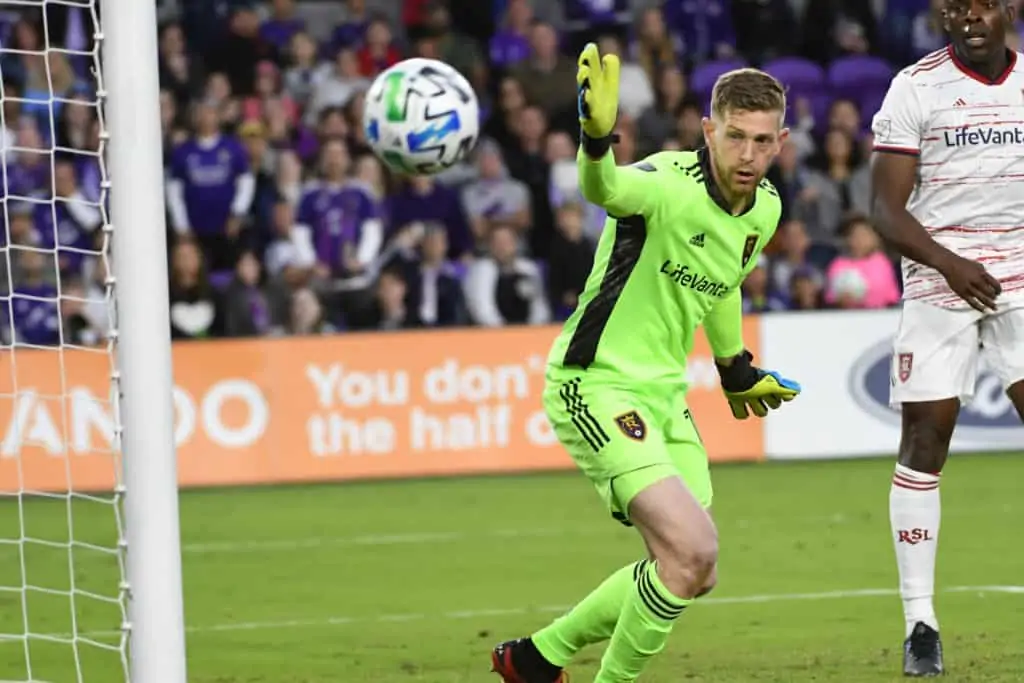Share the post "When Can A Goalie Use Their Hands? (And Can’t!)"
Everyone knows that the one main rule in soccer is that you can’t use your hands. That rule applies to everyone on the field except for the goalie.
The goalie’s main objective is to keep the ball out of the net. Most often, that involves using their hands.
Knowing precisely when and where a goalie can or should use their hands is essential. Simply put, a goalie should use their hands any time they need to prevent the ball from going in their net.
Although the rules are primarily straightforward, not having a good grasp can damage your team. Whether you’re playing, coaching, or watching, make sure you know goalies’ specific rules.
Some of the things you’ll learn in this article are:
- When a goalie can use their hands
- When a goalie can’t use their hands
- If playing goalie can hurt your hands
- How a goalie uses their hands
The goalie is one of the most critical positions on the field. They are often seen as leaders because of the responsibility they hold. They must be strong, confident, and decisive. Many games have been won and lost because of simple mistakes made by a goalie.

Do goalies have to use their hands?
Although a goalie mainly uses their hands, they do not have to. Like other players on the field, goalies are also allowed to play the ball with other body parts.
They can use their feet, chest, and head to control, pass, or make saves.
In reality, if goalies wanted to, they could attempt to make every save with their feet. As most coaches will surely tell you, making saves with your feet is less than ideal.
Saving the ball with anything other than your hands increases the chances that the ball can bounce away and back to the other team.
Goalies have the advantage of being able to use their hands and should use them whenever possible.
Once a goalie has the ball in their possession, opposing players cannot try for the ball until it has been released. An attempt to take the ball is a foul.
Best 3 Goalie Gloves
Product: Updated 2024-04-20 | Images: Amazon Product Advertising API | #ad - soccerblade.com is an Amazon Associate

Can a goalie always use their hands?
A goalie can always use their hands in their penalty box unless it impedes the opposition and causes a foul or a backpass. Outside the penalty box, the goalie can only use their hands for a throw-in.
Being able to react quickly and make the right decision is vital for all goalies.
When a goalie can’t use their hands
In most instances, goalies are able to use their hands. However, there are a few instances where the goalie is not permitted to use their hands;
- A pass back from their own teammate: if a player on your team passes the ball back to you with their feet, the goalie cannot use their hands. In this case, they must use their feet to control and distribute the ball. Using your hands in this situation results in an indirect kick inside of your own box
- After holding the ball for six seconds: although it is rarely called, the six-second rule remains in place to prevent time-wasting. The goalie is not allowed to hold onto the ball for more than six seconds. If they do, the referee can issue an indirect free-kick inside of the 18-yard box.
- Outside of the 18-yard box: goalies are free to move anywhere on the field that they want. However, the only part of the field they are allowed to use their hands is inside the 18-yard box. If a keeper uses their hands outside of the box, it is treated as a handball and a free kick is given where the infraction took place.
- After putting the ball on the ground: a goalkeeper may choose to set the ball on the ground to distribute with their feet after making a save. However, once they have put the ball on the ground, they are not allowed to pick it up again unless the opposing team touches it or it is headed back.

How does a goalie use their hands?
Ideally, teams would want their goalie to catch every single ball that comes their way. This is the safest way to ensure your team has the ball out of harm’s way. Realistically, catching every ball that comes in is not an option.
Does saving a ball hurt a goalie’s hands?
Saving a shot or going up to grab a cross out of the air can be a dangerous game. Shots can come from a very close range at an extremely high velocity. No matter what, it’s the goalie’s responsibility to make the save.
Sometimes saving a ball comes at a cost.
A hard shot can hurt a goalie’s hands, wrists, or arms. Fortunately, there are ways goalies can drastically reduce their chance of injury.
How do goalies prevent injury?
A goalie prevents injury by using protective equipment, like gloves, cleats, padding, and headgear. Anticipation, agility, and timing play a part in choosing when and where to take risks.
Because they use their hands so much, goalies have the added benefit of wearing gloves while they play.
A good pair of gloves is a good tool for any goalie. The gloves that goalies wear have soft padding on the palms that helps absorb the impact of the ball, while also having some grip to make the ball easier to hold onto.
Another way goalies prevent injuries is through training. Practicing proper form on goalie skills can drastically reduce the chances of injury.
Goalies should work on acts such as diving, punching, catching, and jumping in training so that they are prepared for the speed of a game.
Trainers should practice putting their goalies in many different scenarios to prepare them for game speed. As goalies become more advanced, they can progress to more challenging drills. However, working on the fundamentals should always be a priority.

Other ways goalies use their hands
Goalies must work on skills to use their hands to do things other than the catch. Some of the things that a goalie must do are:
- Punch: not every ball that comes into a goalie is catchable. One safe way to get the ball away is to punch it away from the goal. Jumping above the opponents with an extended fist, goalies can punch the ball away from or over the goal and away from danger.
- Parry: often, a goalie will dive into making a save. Catches are hard to make in these cases. Being able to push shots away is an important skill to keeping the ball out
- Distribute: once you have the ball in your possession, the goalie will need to distribute to their teammates. Of course, they can punt the ball up the field or set it down and pass with their feet. They may also roll or throw the ball to them. When done correctly, good distribution will keep possession and can even lead to an attacking opportunity on the other side of the field.
Being the only player on the field who can use their hands is an advantage. Goalies must work on all of the skills needed to keep the other team from scoring.
Share the post "When Can A Goalie Use Their Hands? (And Can’t!)"
Joel is a seasoned soccer journalist and analyst with many years of experience in the field. Joel specializes in game analysis, player profiles, transfer news, and has a keen eye for the tactical nuances of the game. He played at various levels in the game and coached teams - he is happy to share his insight with you.






